
Thank you for visiting HOJO website. If you have any enquiry, please feel free to get in touch with us at
▼ Akira Hojo
▼ Hojo Newsletter
▼ HOJO FACEBOOK





HOME > Green Tea > Hon Yama Hebizuka Sencha
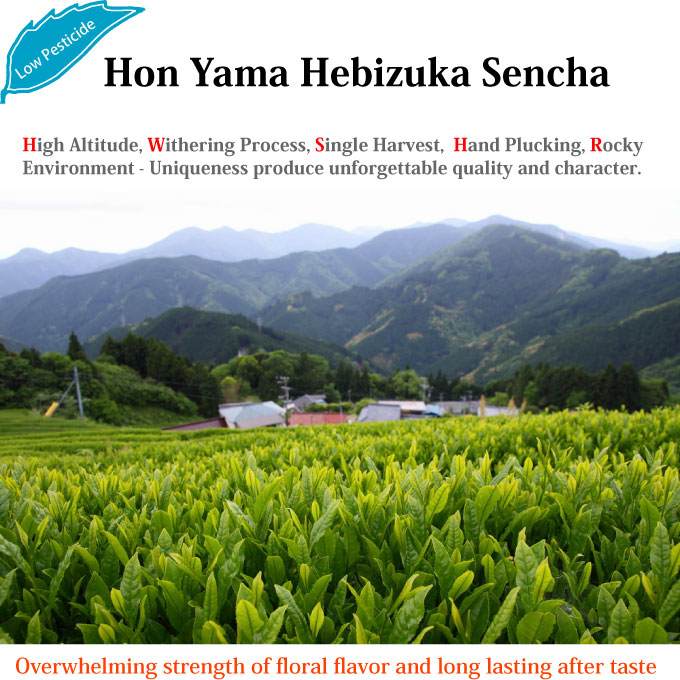

When I meet some elderly people, they often tell me that tea they had drunk when they were young were much more delicious than what they drink now. In the first place, I thought it is just their sentimental feeling of yearning for the past. However, I kept hearing this from many people when I visited the tea manufacturing area. It makes me wonder the major difference between the modern day tea processing methods compared to the old day.
In fact, there is not much difference in the process of tea then and now, except for the rolling method. In modern day, most of Japanese green tea is processed by machine, while in old days tea was rolled by hand; it is called “temomi”. Temomi will make tea look more beautiful and give a thicker taste, but it doesn’t mean the taste is better. The overall character and quality depends on the material, mineral in particular and other processes such as steaming and firing.
In the old days, the process of tea took much longer time. In modern practice, after the tea leaves are plucked, it is sent to factory and processed at once. In the old days, it was impossible to process the tea that fast. Firstly the tea garden was situated on top of the mountain and the farmer did not have the facility to carry the tea back to their factory all at once. Tea was left at the tea garden or factory for several hours or even up to a day, while waiting for the transportation or process.
As a result of this, the tea becomes "naturally withered". Withering causes the dehydration of tea and it triggers an enzymatic ripening. The tea leaves produce various kinds of substance that greatly contribute to the flavor and aroma.
Although the withering process was carried out unintentionally in the old days, it might have been a crucial process that produces tea with a very nice flavor. I assumed that this might have been the reason why elderly people always emphasize that they are longing for the tea that they had drunk when they were young.
Nowadays, it is very hard to find the tea that is processed following the method of the old days. In modern tea making processing, people believe that it is critical to the quality of tea if the process is delayed which might cause it to deteriorate. Therefore, right after plucking, the tea leaves are immediately steamed and processed. This is the reason that ordinary Japanese tea gives a very greenish flavor and less flowery flavor as compare to Chinese green tea. Some tea manufacturers in Japan often apply intensive firing in order to produce a nutty flavor. But this is different from a flowery flavor.
I was very surprised when I came across Hon Yama Hebizuka Sencha. It is exactly the tea that follows the old method of making tea. In making Hon Yama Hebizuka Sencha, the withering process is carried out on purpose. After plucking, tea is not processed in the same day. Tea leaves are left for 24 hours in a bamboo basket and is only processed the next day. Thanks to the withering process, Hon Yama Hebizuka Sencha gives a very sweet and flowery flavor.
There is another reason that makes Hon Yama Hebizuka very special. Usually most of Japanese green tea is grown at very low elevation. It is due to the climate of Japan. Most of the tea garden in Japan is located at high latitude. There is 4 seasons and in winter, the environment is very cold. However Hon Yama Hebizuka tea garden is located at very high elevation. Its altitude is at about 800m. In Japan, 800-1000m is almost the growing limit of tea tree.
The high mountain weather gives 2 significant benefits.
Higher up on the mountain, the sunshine is stronger. Likewise, we easily get sun-burned when we go to higher altitudes for trekking or sky diving. Tea receives a lot of sunshine in a day time and effectively carries out photosynthesis. Tea produces a lot of organic substances and stores them inside its leaf. At night, the tea leaves will consume the energy (organic substance) for metabolism. At high altitudes, the environment is very different and the temperature at night is very cold that tea can hardly proceed metabolism effectively. After all, most of the organic substances are accumulated inside tea leaves which makes the taste of tea becomes very thick.
In winter, the mineral absorbed by the tea trees from the ground will be accumulated inside the tree. It is because of the plant remains dormant during the very cold environment. This is the resting period of the plant. More mineral will be accumulated in the tree if the resting period is prolonged. The accumulated mineral will be distributed into the first up-coming tea leaves in spring. Mineral in tea is the primary element that contributes to the long lasting after taste. In a way, the longer the resting period of tea, the better the taste of tea. In addition, Hebizuka tea is plucked only once a year in spring. Moreover at high mountain like Hebizuka, winter comes earlier while spring comes later as compared to lower altitude areas. As such, the tea trees has even longer resting period. Tea contains an extraordinary amount of minerals. In Hebizuka mountain area, there are plenty of stones which are rich in iron content. Iron is one of the best minerals that contribute to the ideal taste of tea.
Hebizuka tea has a very strong floral flavor and lingering after taste thanks to a very unique process and special environmental/geographical advantage.
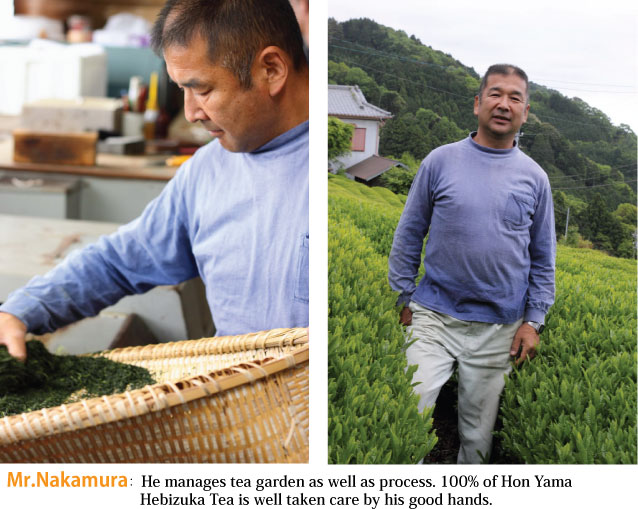
Hon Yama is located deep inside Shizuoka city. The name of Hon Yama is used for the tea grown along the Abe River or Warashina River stream. Abe River is one of the steep and clear-water rivers in Japan. There are a number of slope along the river side. This place is covered by fog and the daytime is short that limits the growing speed of tea and makes flavor and taste of tea thicker.
The literature (東福寺志) stated that the first tea bush was seeded by a monk during Kamakura era (year 1244). According to the oldest record of Japanese tea written in 1211 by a monk named Ei Sai (栄西), Hon Yama tea was one of the oldest teas in Japan.
The tea produced along the Abe River was usually meant for the high-end market in Japan. In order to differentiate their quality from ordinary green tea, the name Hon Yama was given as a brand to represent its premium quality. The fame of Hon Yama tea reached the climax thanks to Shogun Tokugawa Ieyasu who founded the Edo Era. According to the records, the Shogun Tokugawa constructed the tea store deep inside the mountain at the upstream of Abe River in order to maintain the quality of his tea.
Hebizuka is the name of the mountain located at the highest point of Hon Yama area. It is a very small area where only 10 families stay near the peak of Hebizuka. Out of 10 families, only a few families are involves in the tea business. In Hebizuka, the person who plant tea is also in charge of making tea. Each family has a small tea making facility that is attached with their own house. Our Hon Yama Hebizuka is made by Nakamura family.
Shizuoka is well known for fine Sencha and Deep Steamed Sencha. I often heard from my customers who commented that "they do not really like Sencha". To be honest, I wonder what type of sencha they are referring to. As a matter of fact, any tea produced in Japan could be named as Sencha. But if you want to experience the fine quality, you can not miss Sencha produced in Shizuoka..
Basically Shizuoka tea garden consists of 2 kinds as follow.
The tea garden is at a higher elevation. Each garden produces quality tea rather than the quantity.
Hon Yama is classified as mountain tea. Each tea garden is kept in a small scale and managed by respective families. The majority of the tea gardens are located at the steep slope of the mountain. The name of Hon Yama Tea is applied for the garden that is situated along the Abe River stream. Abe River flows from Japan Southern Alps (3000m above sea level). It takes 50 over kilometer to reach Pacific Ocean.
Hebizuka tea is also one of the Hon Yama Tea. Hebizuka is the name of the peak that is located at the upper stream of Abe River. The altitude of Hebizuka is at around 750-800m. Due to the high latitude of Japan, the tea tree cannot survive over the winter if it is grows at an altitude more than 1000m above sea level. Considering that, the altitude of the Hebizuka tea garden is almost the growing limit of tea in Shizuoka.
In Hebizuka, due to the high altitude, spring comes a month later and winter comes a month earlier than ordinary tea gardens in Shizuoka. Eventually Hebizuka has additional 2 months of resting period in winter. The longer resting period helps tea to accumulate minerals. Therefore, the first up-coming tea leaves are very rich in mineral and gives a strong after taste and you can also enjoy the flavor that slowly meanders down the throat. On the other hand, the tea tree planted at lower elevation contains less mineral and therefore it lacks the depth of after taste and flavor, although it gives strong aroma. The quality of tea is in proportion to the intensity of after taste. The long resting period is an essential factor to produce the fine quality.
Despite of high quality of Hon Yama Hebizuka Sencha, the price of this tea in the market is comparatively low. In Japan, the earlier the new season tea is introduced, the higher the price. It is due to the culture of the Japanese who always appreciate the fresh crops. The first batch of Japanese green tea is produced in the middle of April. This is the time when everyone is aware of the new tea season. Basically the most of the tea gardens in Japan finish their harvesting by the first week of May. However, in Hebizuka area, due to the higher elevation, the spring comes one month later. The plucking of first flush is only started in the middle of May. This is exactly a month later than the first spring tea in the market.
After all, tea market in Japan does not appreciate the late harvest tea and eventually gives lower price even if tea is extremely high quality. The farmer, Mr. Nakamura is very much aware of this fact. He does not sell his tea to Shizuoka central tea auction, but directly sell to respective tea company who understands the quality and appreciates his tea. Considering that Hon Yama Hebizuka is only produced by Mr. Nakamura, it is a very limited tea. Only a few companies have the privilege of dealing with his tea.
In fact, there is another factor that makes Hebizuka tea very special. The name of Hebizuka in Japanese is “The Grave of Snake”. When you have a chance to visit the Hebizuka area, you will spontaneously associate the name with its geographical condition. Hebizuka area has many rocks and its appearance resembles those seen in Yi Xing (China), Sado Island and Iga Mountain in Japan. They are all purple, yellow or red in color. If those rocks are found in Yi Xing, people no doubt think these are purple sand: Zisha. The colors of rocks indicate that the soil in Hebizuka is very rich in “Iron” content. Iron is the most essential mineral that contribute to the after taste of tea.
In addition, the mineral-rich soil is very poor in nutrition and fast to drain water. Under such restricted environment, tea grows slowly. As a result, the flavor and taste is highly concentrated inside tea leaf that gives a very rich flavor and strong after taste.
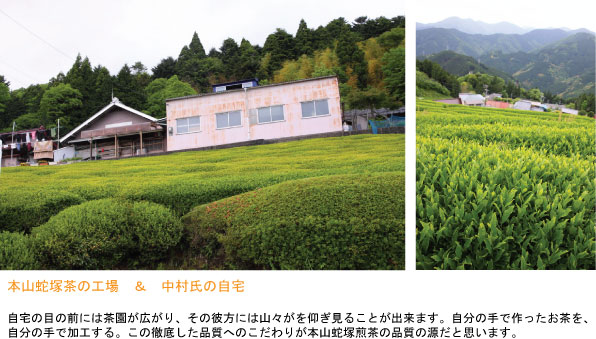
Hon Yama Hebizuka Gyokuro is produced from Yabukita cultivar. Plucking is carried out only once a year in the middle of May. Thanks to the limited number of plucking, the mineral content in tea leaf is much higher than ordinary tea. Tea leaf is hand-plucked. Each twig consists of one bud and two leaves.
Hon Yama Hebizuka Gyokuro undergoes the withering process so as to enhance its floral character. In order to maximize the effect of withering, the tea leaves needs a higher percentage of poly phenol. The withering process is the internal ripening process that converts poly phenol into various kinds of flavor. Young tea leaf contains very rich in amino acid which is converted into poly phenol during photo synthesis. Therefore tea leaf is not harvested until it grows to slightly bigger size than ordinary standard.
Plucking starts after the sunrise in order to avoid the morning dew. The present of morning dew on the tea leave will cause partial over-heating during the steaming process. This will destroy the tissues of tea leaves and affects the quality. Therefore the good tea must be produced from tea leaves plucked during a sunny day.
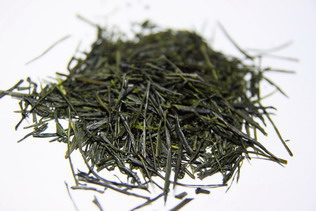
Mr. Nakamura owns a very limited number of tea gardens. Basically the tea leaves are not mixed. Hon Yama Hebizuka is processed from the single origin from the identical tea garden. In Mr. Nakamura's family, 100% of his tea is hand-plucked. No machine plucking is being carried out.
After plucking, the tea is gently placed inside a small bamboo basket. A hole is made in the middle of piled tea leaves to provide effective ventilation. Withering process is carried out under the shade with good ventilation for 24 hours. During the withering process, internal enzyme is triggered to start the ripening. It is the same mechanism as hanging unripe pineapple for further ripening. Another example is that hey usually gives a sweet aroma, while grass gives a very greenish aroma right after being cut. These involve the same mechanism.
The enzyme is triggered by dehydration and mediate moderate ripening process. Ripening is kind of oxidation or enzymatic hydrolysis that produces various kind of volatile substance. In tea leaves, those volatile substances give a floral aroma and flavor.
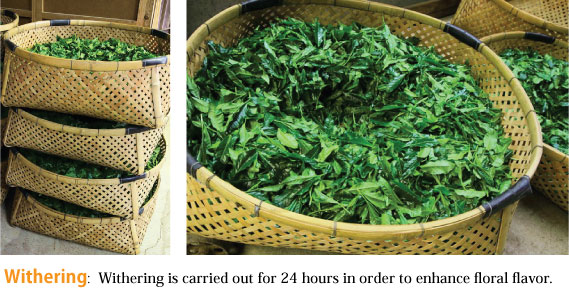
The quality of Sencha is also affected by the steaming process. In order to bring out the identical character of Hon Yama tea, the steaming process is conducted at a very short time, about 30 seconds. Tea leaves are steamed at a very high temperature but in a short time so that it become very dry and will not regain the moisture by condensation. This is one of the key points to produce good quality teas.
Tea leaves have to be cooled down quickly after steaming. Immediate decrease of the wet heat is very important to avoid secondary heating of tea leaves. At the same time, the tea leaves will evaporate the moisture.
Tea leaves are agitated with hot air for further drying. At the same time, the mixing will soften the leaves.
This is the only process conducted without heat. The machine moves in a circular motion with pressure that spread the moisture of tea leaves evenly. The tea leaves generate heat due to the friction. Therefore, it is necessary to loosen the tea leaves and release the heat at regular intervals.
A rotary dryer is used to roll the tea leaves gently and twist the tea leaves into a finer shape. It is also part of the drying process to further reduce the moisture of tea leaves.
It is a reciprocal movement of back and forth; combine with a circular motion to twist the tea leaves into a fine needle shape. High quality Sencha is dark green in color, shinny and solid.
After the final rolling, the tea leaves still contain moisture. Drying will reduce moisture to about 5%. These leaves are called Aracha (crude tea). Aracha does not undergo the firing process. Compared with the finished tea product, the flavor of fresh leaves and bitter taste is very strong.
i. To reduce the moisture of tea leaves so that it lasts longer.
ii. Heating will enhance the flavor of tea.
Every tea wholesaler in Japan purchases Aracha as raw material and they will blend a few kinds of tea. Subsequently, they will conduct firing following their individual process. This is how they create their original brand.
As for Hojo’s Hon Yama Sencha and Hon Yama Hebizuka Sencha, we emphasize on the single origin. In order to maintain its natural floral bouquet and refreshing flavor, we conduct very short firing process so that most of substances are not oxidized.
Sencha gives a well-balance taste of bitterness, astringency and sweetness (umami). Each taste comes from different types of substance. The taste varies a lot depending on the brewing method. We suggest that everyone should learn the standard method, and after understanding it, develop your own method and enjoy your cup of tea. For the tea ware, we recommend either purple clay or red clay tea pot. Purple clay gives a strong flavor, while aroma is slightly weak. Red clay maintains the aroma but flavor is not as strong as being brewed using purple clay.
In the long run, you may observe a thick layer of scale accumulated inside your kettle. Our mother usually taught us to wash and remove it with citric acid. But please do not even try to remove the scale. Scale consists of minerals that exist in the water. The mineral composition is reflected from the water you used. If you remove the scale, the mineral ion balance between scale and water is destroyed. This balance is called buffer effect in science. The flavor and taste will seriously run out and you won’t be able to get previous taste and flavor for a long time. It is also important to stick to the same type of water whenever brewing tea. If source of water is changed, it carries different type of minerals. It will affect the mineral ion balance too.
Go to further information about suitable water for brewing tea >>
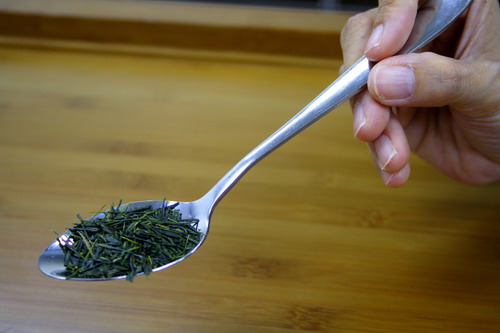
To determine the quantity of tea leaf to be used, we divide the volume of water by 5. For example: the volume of teapot = 200ml; 200ml/50 =4g. You need to measure 4g of tea leaf for 200ml of water.
It is important not to use boiling water. Boiling water should be poured into an empty glass or any container, let it cool down to 70-80 degree C. As Hon Yama Hebizuka Sencha undergone the withering process, the brewing temperature should be slightly higher than normal sencha (which brew at 70 degree C).
Pour the hot water into the tea pot, and brew for 1 minute. For second and third brewing, use the same temperature as first brewing. The brewing time for 2nd and 3rd brewing is as short as a few seconds. For 4th and 5th brewing, prolong the brewing time for additional 10 seconds. The 6th brewing onward, progressively increase the brewing temperature in order to maintain the thickness of taste. At last, you can use boiling water to brew tea. In particular, 2nd brewing is the most important. If the 2nd brewing is extended for more than a few seconds, the total number of brewing is affected.
Traditionally, the Japanese never use a pitcher during serving of tea. The tea is directly poured from the tea pot into respective tea cups. In order to make the concentration even, we should pour into one cup after another, repeating a few times until the last drop of tea. The purpose of pouring until the last drop is to extract the concentrated liquor. This is important as tea leaves must be well filtered and kept without water to avoid the liquor becoming bitter and stewed. Besides, it prevents tea leaves from being over cooked. In addition, filtration will make it ready for the next brewing.After pouring the tea, you have to lift the lid open to avoid further steaming of tea leaves.
After pouring the tea, you have to leave the lid open to avoid further steaming of tea leaves.
Once a bag of tea is opened, please finish it within 3 months if you wish to enjoy its freshness. From the medical point of view, it is safe to consume the tea even if it is kept for a few years. However the freshness disappears if it is kept for too long. Tea must be tightly sealed before it is kept. Tea should be kept in ambient and dry conditions such as in the living room, but it must be completely away from humidity. Tea should not be kept in the kitchen as the environment is very humid. Avoid enclosed area such as inside the cupboard or drawer as these places are damp. Also avoid opening the bag of tea in humid atmosphere. It is recommended to open the bag during a sunny day or under air-conditioned atmosphere. Once tea leaves absorb moisture, deterioration of tea will be triggered within a few days. Tea will then give an astringent taste, sometime it tastes sour. The fresh aroma also becomes weaker.
The quality of tea lasts longer if it is kept in the fridge. However we strongly recommend you not to keep tea in the fridge. When tea is withdrawn from the fridge, there is usually condensation. Once tea is exposed to moisture during condensation, the quality will deteriorate within a few days. The higher moisture content in the tea leaves will trigger oxidation and it will completely destroy the quality of tea.
Here’s one frequently asked question: what happens if bag is sealed using tape or tea is packed in zipper bag and kept inside the fridge?
For your information, these simple sealing methods are not sufficient. When the bag is withdrawn from the fridge, it is cold inside the bag and therefore causes negative pressure. Air will be drawn from outside and condensation will occur. In addition, if the bag is taken in and out from the fridge very often, this will cause heat stress to the tea leaves as temperature is increased and decreased very frequently. If tea is kept in the fridge, when it is withdrawn from the fridge, it is necessary to leave it in ambient atmosphere for more than 24 hours in order to warm up the tea leaves. Based on our experience, 12 hours is not long enough. We may think tea is warmed up, but inside the bag, the tea leaves are still cold due to insulation effect.

Please feel free to send us e-mail for enquiry at:

 |
We accept various kinds of credit card through Paypal.
Only if customer prefer other option of payment, we suggest "Bank Transfer".
Various choice of shipping method
EMS, SAL, Small Packet, Small Packet (SAL) Yamato Express and Surface
For shipping tea, we usually suggest small air parcel, the estimated shipping cost of tea in 100g (with wrapping material ) is
Small Parcel
USA JPY 600, EU JPY600 and Asia JPY470
Small Packet (SAL)
USA JPY380, EU JPY380 and Asia JPY320
The shipping fee to oversea by small air parcel happens to be even cheaper than domestic shipping fee in Japan.
For your information, some countries, EU in particular imposes custom duty. We need buyer to bare the duty. We are sorry, but we cannot change the amount on the invoice, and we do not mark any packages as gifts. We will strictly follow the custom regulation.